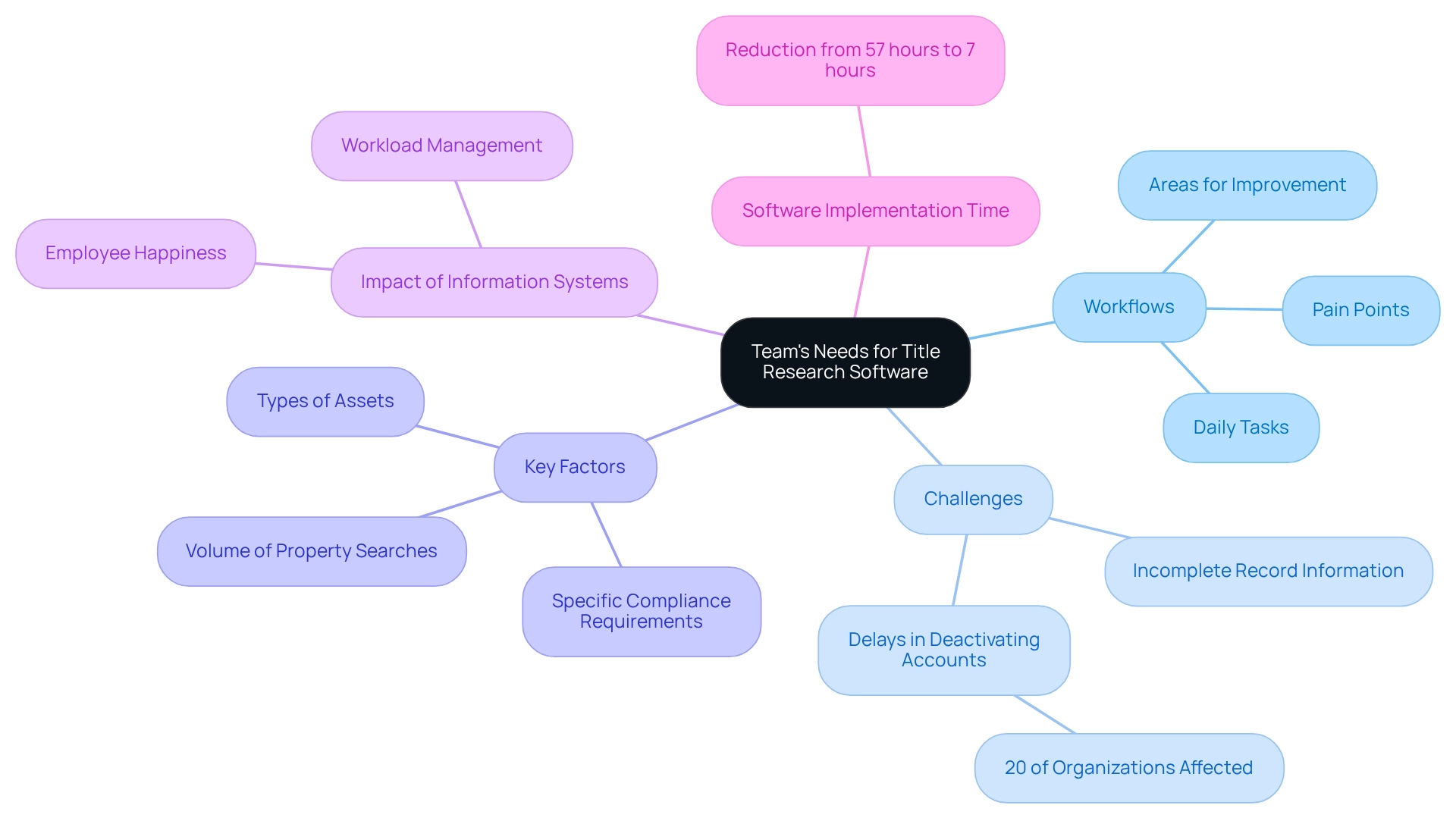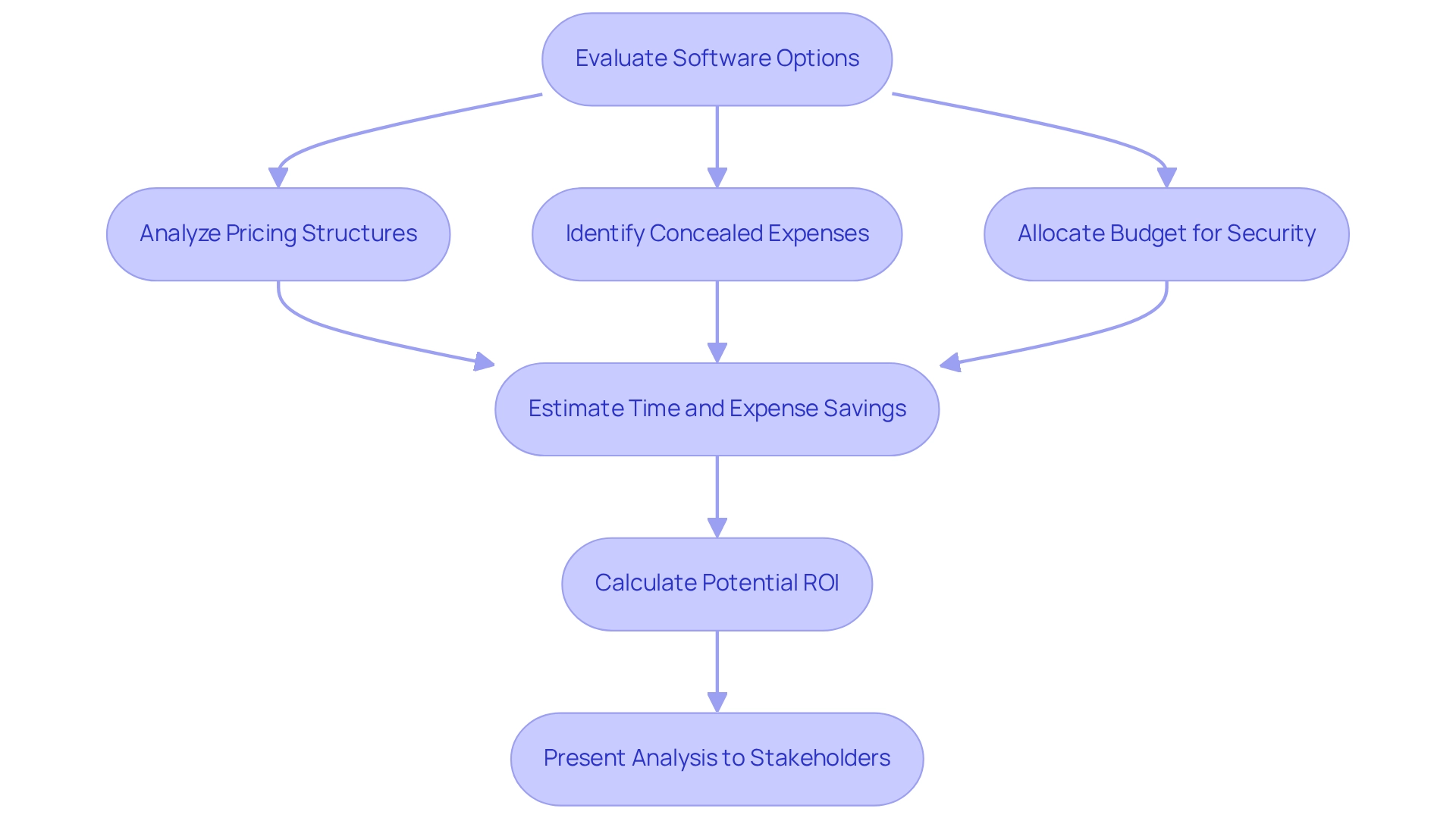Overview
The article primarily focuses on delivering a structured approach for selecting real estate software that incorporates curative title modules. It emphasizes the necessity of aligning the software with specific team needs and enhancing operational efficiency. This is supported by outlining four critical steps:
- Assessing team requirements
- Evaluating key features
- Ensuring usability and integration
- Analyzing cost-effectiveness
Each step plays a vital role in facilitating informed decisions that ultimately enhance productivity and streamline title research processes.
Introduction
In the realm of title research, the right software can be a game-changer, transforming tedious processes into streamlined operations. As teams grapple with the complexities of title searches, understanding their specific needs becomes paramount. By engaging with team members and assessing workflows, organizations can pinpoint the essential features that will enhance efficiency and productivity.
Furthermore, from automated lien resolution to user-friendly interfaces, the landscape of title research software offers a plethora of tools designed to meet diverse challenges. This article delves into the critical factors to consider when selecting title research software, ensuring that teams not only improve their operational effectiveness but also achieve a significant return on investment.
Identify Your Team's Specific Needs for Title Research Software
To efficiently select research software for titles, begin with a comprehensive evaluation of your group's workflows and challenges. Engage directly with team members to gather insights regarding their daily tasks, pain points, and areas for improvement. Key factors to consider include:
- The volume of property searches
- The types of assets managed
- Specific compliance requirements
Documenting these needs will establish a clear reference point for evaluating software options. For instance, if your group frequently encounters difficulties with incomplete record information, prioritize solutions that feature robust data verification capabilities.
Recent statistics indicate that 20% of organizations face delays of a month or longer in deactivating ex-employee accounts, which can hinder overall efficiency in research processes. This underscores the necessity of streamlined workflows and effective data management. As N. Shevchenko noted, " ensure data and information unity between different departments, enabling quick and efficient decision-making processes."
Moreover, the introduction of new applications has significantly improved, now requiring approximately 7 hours compared to 57 hours a decade ago, highlighting the demand for efficient tools that enhance productivity. By understanding your group's workflows and selecting applications that align with their specific needs, you can substantially improve research efficiency and overall workplace satisfaction.

Evaluate Key Features of Curative Title Modules
When assessing applications, prioritize features that significantly enhance your team's efficiency. Crucial modules in real estate software with curative title modules should feature , simplifying the process of recognizing and resolving ownership issues. AI can assist firms in generating new business in a competitive market, making it essential to evaluate tools that utilize this technology.
Furthermore, search for thorough document management solutions that offer real-time updates on status, ensuring that your group has access to the most current information. Collaboration tools are also essential; real estate software with curative title modules can enable effortless sharing of document names and communication among group members and outside stakeholders, significantly improving the curative process.
To guide your evaluation, create a checklist of must-have features tailored to your team's specific needs. Integrating statistical tools with visualization features, like bar charts and histograms, can further assist in examining data and enhancing decision-making procedures. For example, utilizing Monte Carlo simulations can automate cost assumption analysis, leading to more accurate and efficient outcomes in title research.
Leadership must communicate the benefits of AI adoption, emphasizing that these tools augment—rather than replace—human roles. Additionally, features like Advanced Search and Key Statistics Scheduled Reports can enhance your document management and reporting capabilities.
Assess Usability and Integration with Existing Systems
When evaluating potential application solutions, it is essential to prioritize an intuitive user interface that simplifies navigation. As the esteemed designer Ellen Lupton aptly states, "Design is storytelling," underscoring the critical role of user-friendly design in effectively conveying functionality.
Conduct trials or demonstrations with your team to gather invaluable feedback on usability, ensuring that the application aligns with the practical needs of your workflow. Furthermore, it is vital to assess how seamlessly the application integrates with your existing systems, such as CRM or document management platforms. Seek solutions that offer APIs or built-in integrations to facilitate effortless data sharing and enhance operational efficiency.
For instance, if your team relies on a specific document management system, confirm that the new application can easily connect to it, thereby streamlining your title research processes. Statistics reveal that investing in user experience early in the selection process can lead to improved design outcomes and reduced costs associated with post-launch modifications. This is further supported by the case study titled "Investing in UX Early in Development," which highlights the advantages of prioritizing user experience design at the outset of the product development process.
Additionally, it is important to remember that the most successful products evolve based on and insights, reinforcing the necessity for continuous improvement driven by user feedback.
Consider Cost-Effectiveness and ROI of Software Solutions
When evaluating software options, it is crucial to conduct a thorough analysis of their pricing structures. Be cautious of concealed expenses, such as implementation fees, training charges, and ongoing maintenance costs, as these can significantly impact the overall expense of ownership.
Financial experts have observed that security measures and solutions will require a portion of the budget; however, they will protect you from much greater costs associated with data breaches and reputational damage. To effectively calculate potential ROI, estimate the time and expense savings that the application could provide. For instance, if a solution can reduce the time dedicated to document searches by 30%, convert that time savings into labor savings.
Presenting this detailed analysis to stakeholders not only supports your selection decision but also emphasizes the financial advantages of investing in automated title curative solutions. Furthermore, consider the broader financial implications of technological solutions, including hardware disposal and associated costs, which are critical in total cost of ownership considerations.
Financial analysts emphasize that understanding these metrics is essential for maximizing returns on with curative title modules investments, ensuring that the selected solution aligns with both operational efficiency and budgetary constraints.

Conclusion
Selecting the right title research software is a pivotal decision that can significantly enhance team efficiency and operational effectiveness. By thoroughly assessing the specific needs of a team, organizations can identify essential features that address their unique challenges. Engaging with team members to understand their workflows not only uncovers pain points but also informs the selection of software that aligns with those needs, ultimately leading to improved productivity and workplace satisfaction.
Furthermore, evaluating key features such as automated lien resolution, real-time document management, and effective collaboration tools is crucial. These functionalities not only streamline processes but also leverage advanced technologies like AI, which can propel title companies ahead in a competitive market. The emphasis on usability and integration with existing systems cannot be understated; a user-friendly interface and seamless connections with current platforms are vital for maximizing the software's potential.
Finally, a careful analysis of cost-effectiveness and potential ROI is essential. Understanding the total cost of ownership, including hidden fees and long-term savings, ensures that the investment in software yields significant financial benefits. By prioritizing these factors in the selection process, organizations position themselves to make informed decisions that enhance their title research capabilities and drive substantial returns on investment. Embracing the right software solutions is not just a technological upgrade; it’s a strategic move towards greater efficiency and success in title research operations.
Frequently Asked Questions
How should a team begin selecting research software?
A team should start by conducting a comprehensive evaluation of their workflows and challenges, engaging directly with team members to gather insights on daily tasks, pain points, and areas for improvement.
What key factors should be considered when selecting research software?
Key factors to consider include the volume of property searches, the types of assets managed, and specific compliance requirements.
Why is documenting team needs important in the software selection process?
Documenting team needs establishes a clear reference point for evaluating software options, ensuring that the selected solutions align with the group's specific challenges and requirements.
What issue do many organizations face regarding ex-employee accounts?
Recent statistics indicate that 20% of organizations experience delays of a month or longer in deactivating ex-employee accounts, which can hinder overall efficiency in research processes.
How can effective data management impact research efficiency?
Streamlined workflows and effective data management are necessary to enhance research efficiency, as they facilitate quicker and more efficient decision-making processes.
How has the introduction of new applications affected the time required for implementation?
The introduction of new applications has significantly improved, now requiring approximately 7 hours for implementation compared to 57 hours a decade ago, highlighting the demand for efficient tools that enhance productivity.
What is the main goal when selecting software according to the article?
The main goal when selecting software is to understand team needs, which helps in selecting applications that align with specific requirements and improves overall research efficiency and workplace satisfaction.




